Navigation » List of Schools » California State University Dominguez Hills » Science, Mathematics and Technology » SMT 314 – Introduction to Cosmology » Fall 2020 » Exam 1
Question #1
A star groups are stars close together
B our astrological future
C star groups are stars close together
D north, and seasons; as Earth rotates
E Greek legends
Question #2
A TRUE
B FALSE
Question #3
A Like the Sun, stars move up over the horizon during the daytime
B Stars appear to rise above the horizon (or fall beneath) as the Earth rotates
C Rising is dawn and setting is dusk
D Stars move around the Earth
Question #4
A never, because the same face always faces Earth.
B never. It also doesn’t revolve about anything.
C roughly once a month
D once an Earth day
Question #5
A year; day
B day; year
C month; year
D month; day
Question #6
A TRUE
B FALSE
Question #7
A TRUE
B FALSE
Question #8
A always appears within a few degrees of the solar ecliptic.
B generally appears opposite the Sun.
C always appears within a few degrees of the celestial equator.
D may appear anywhere in the sky.
Question #9
A September 21-22
B March 20-21
C December 20-21
D June 20-21
Question #10
A the motion of the planets across the sky.
B the revolution of the Earth.
C the motion of the Sun around the galaxy.
D the rotation of the Earth.
Question #11
A as far apart as possible
B in ellipses in random directions
C bound by gravity of the planets
D around the Sun in roughly the same plane
Question #12
A The Moon orbits about the Sun and is independent of Earth.
B The Moon has a chaotic orbit. (The Moon has more mass on one side.)
C The Moon’s orbit is not the solar ecliptic.
D The Moon’s orbit is an elliptic.
Question #13
A FALSE
B TRUE
Question #14
A The Moon is still visible during a total lunar eclipse because of light going through the Earth’s atmosphere.
B Lunar eclipses don’t occur monthly, because the inclination of the Moon’s orbit around the Earth relative to the Earth’s orbit around the Sun.
C Total lunar eclipses last longer than total solar eclipses
D Lunar eclipses are predictable.
E At a given time, a total lunar eclipse is visible only from a small part of the Earth’s surface.
Question #15
A If you lived on Mercury, you would notice that Earth exhibits retrograde motion for a while every year.
B As seen from Earth’s surface, planets rise in the east and set in the west, even when they undergo retrograde motion.
C According to Kepler’s first law, the orbit of planets are ellipses with the Sun at one focus; there is no object at the second focus.
D Our observations of a full or gibbous Venus provide evidence against the Ptolemaic, Earth-centered model of the Solar System
E Copernicus’ model of the Solar System was accepted shortly after being proposed, because it provided significantly more accurate positions of the planets than did the Ptolemaic system.
Question #16
A They can be viewed safely with the naked eye, for the entire event.
B They can be observed from an entire hemisphere on Earth.
C They occur when the Sun or Moon are in Earth’s shadow.
D They look reddish primarily due to the refraction and scattering of light passing through the Earth’s atmosphere.
E They last about the same amount of time.
Question #17
A elliptical orbits.
B gravity.
C the Milky Way is full of stars.
D the Sun is at the center of the universe.
Question #18
A TRUE
B FALSE
Question #19
A crescent
B Full Moon
C quarter
D gibbous
Question #20
A All of these.
B Extraordinary claims require extraordinary proof.
C Not believing everything you hear.
D Considering the credibility of the sources.
Question #21
A comparing results with expectations
B expressing the results as a “law” or “principle”
C collecting data
D a careful analysis of data
E making an educated guess
Question #23
A Summer days would be even hotter, on average.
B The days and nights would each remain roughly 12 hours long around March 22 and September 22, the equinoxes.
C The Sun would pass essentially overhead (the zenith) around June 22, the summer solstice.
D The summer would have even longer days and even shorter nights.
E There would be a longer combined spring and summer period.
Question #24
A FALSE
B TRUE
Question #25
A Is caused by the motion of Venus along an epicycle whose center orbits the Sun
B Is caused by the gravitational tug of other planets on Venus
C Is caused by the “backward” rotation of Venus about its own axis
D Is caused by the change in perspective as Venus catches up with, and passes, Earth while both planets orbit the Sun
E Was used by Galileo to explain the complete set of phases of Venus that he observed through his telescope
Question #26
A TRUE
B FALSE
Question #27
A The tilt of Earth’s axis of rotation causes one hemisphere of the planet to be substantially closer to the Sun during the day than the other hemisphere. Because it is closer to the Sun, it receives much more solar energy per hour.
B Over the course of the Year, the tilt of Earth’s axis of rotation varies from 23.5° to 0° in such a way as to bring more heating per hour in the summer than the winter.
C The tilt of Earth’s axis of rotation causes the Sun to pass higher in the sky during the day in one hemisphere than in the other, thereby giving more daylight hours and more heating per hour per surface area.
D Earth’s orbit is elliptical. We have summer when we are closer to the Sun and winter when we are farther from the Sun.
E It has seasons so that sunbathers will know when to go to the beach, and skiers will know when to go skiing.
Question #29
A TRUE
B FALSE
Question #30
A is the distance from the Earth to the Moon
B the distance from the center of the Sun to the center of the Earth
C used primary to measure things within the solar system
D varies dependant upon the time of year
E a measurement of distance
Question #31
A Earth rotates under the stars
B in daytime only the Sun moves
C whole constellations move together
D the stars rotate about the Earth
Question #32
A Light moves instantly from all objects to Earth.
B Light causes many optical illusions.
C Different colors of light travel at different constant speeds.
D We see distant objects as they were long ago.
Question #33
A The Moon is not in a shadow.
B Earth
C Sun
D Moon
Question #34
A Venus rotated about Earth.
B Venus revolved about the Sun.
C Both Venus & Mars had epicycles.
D Copernicus was wrong.
Question #35
A from East to West
B randomly
C in circles
D from West to East
Question #36
A the Summer Solstice in the southern hemisphere
B the longest day of the year in the southern hemisphere
C when the southern hemisphere is much closer to the Sun
D 3 – 4 days before Christmas
E when the north pole is pointed away from Polaris
F the Summer Solstice in the Northern Hemisphere
Question #37
A TRUE
B FALSE
Question #38
A TRUE
B FALSE
Question #39
A believed by at least 50% of all scientists
B reproducible
C believed by 100% of all scientists
D hypothetical
E controversial
Question #40
A TRUE
B FALSE
Question #41
A it varies year to year
B 0 hours
C 12 hours
D 24 hours




